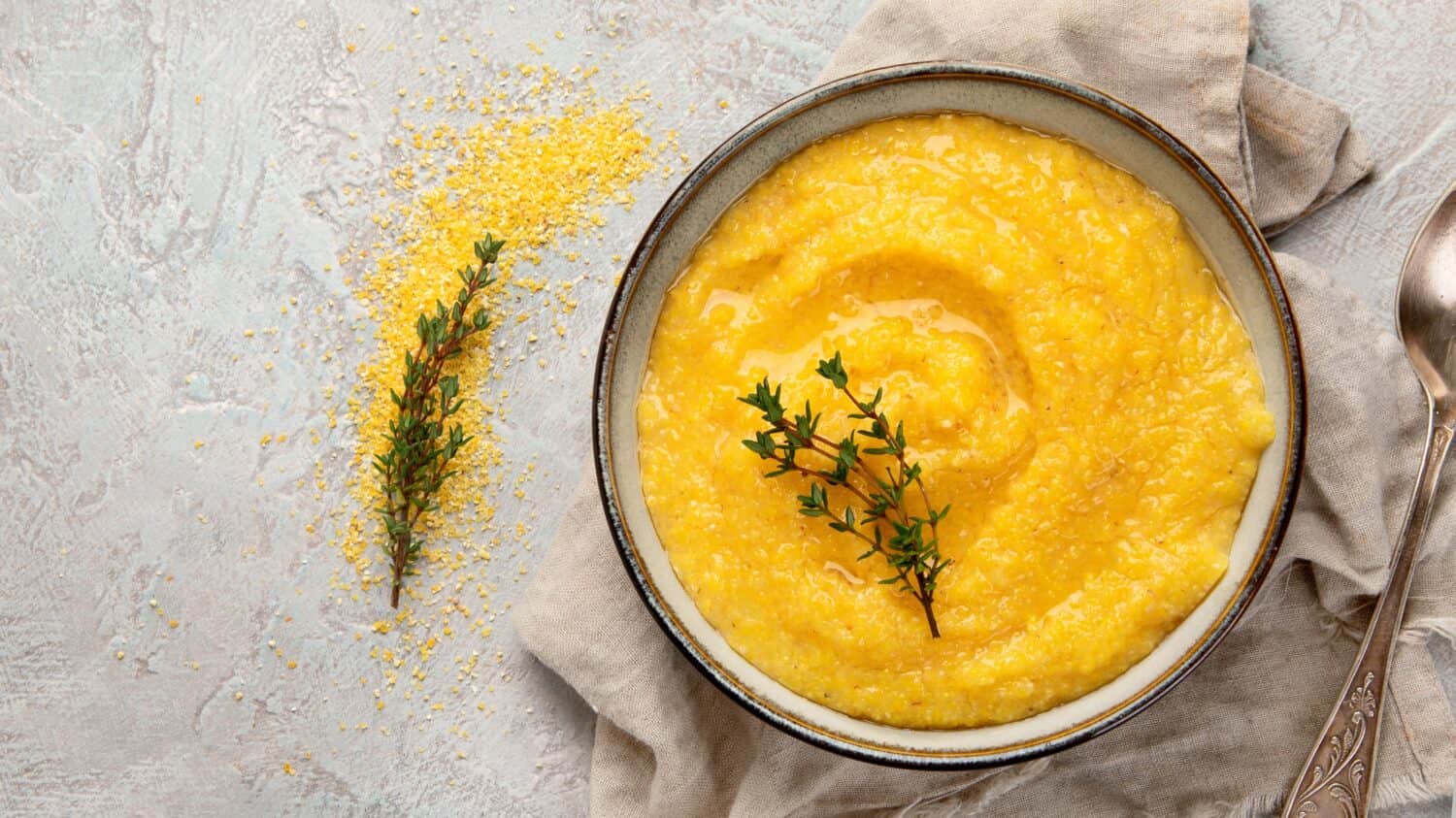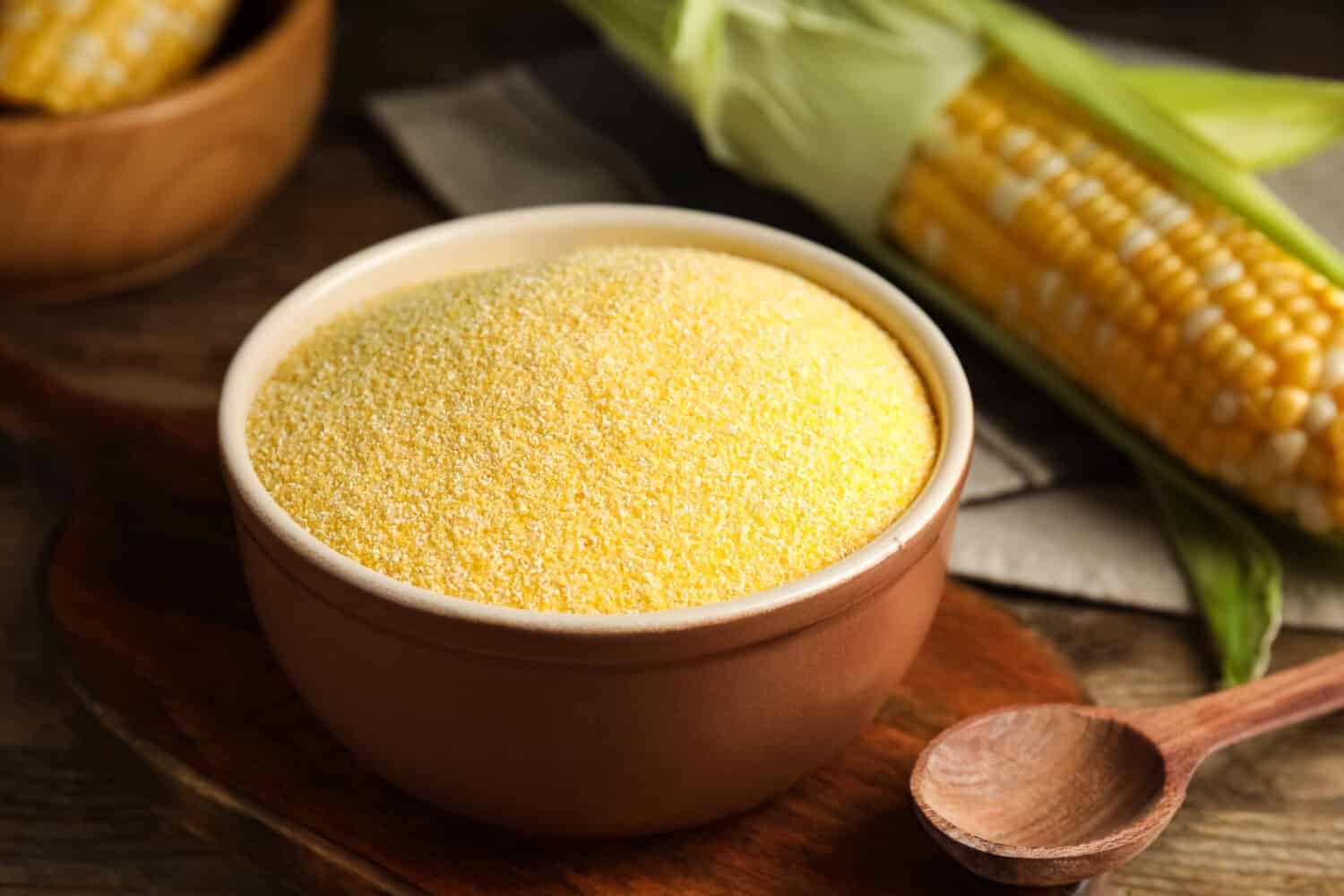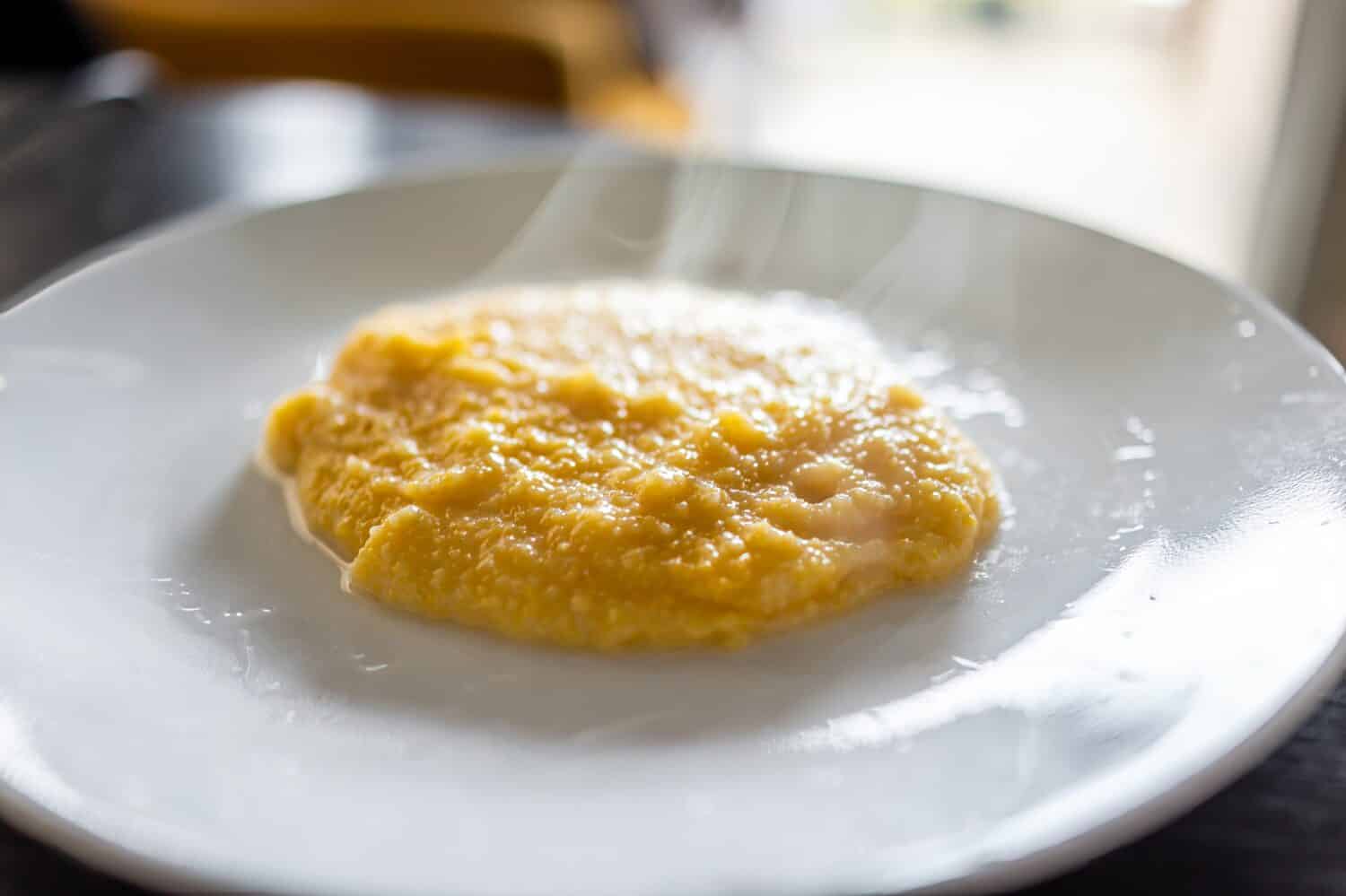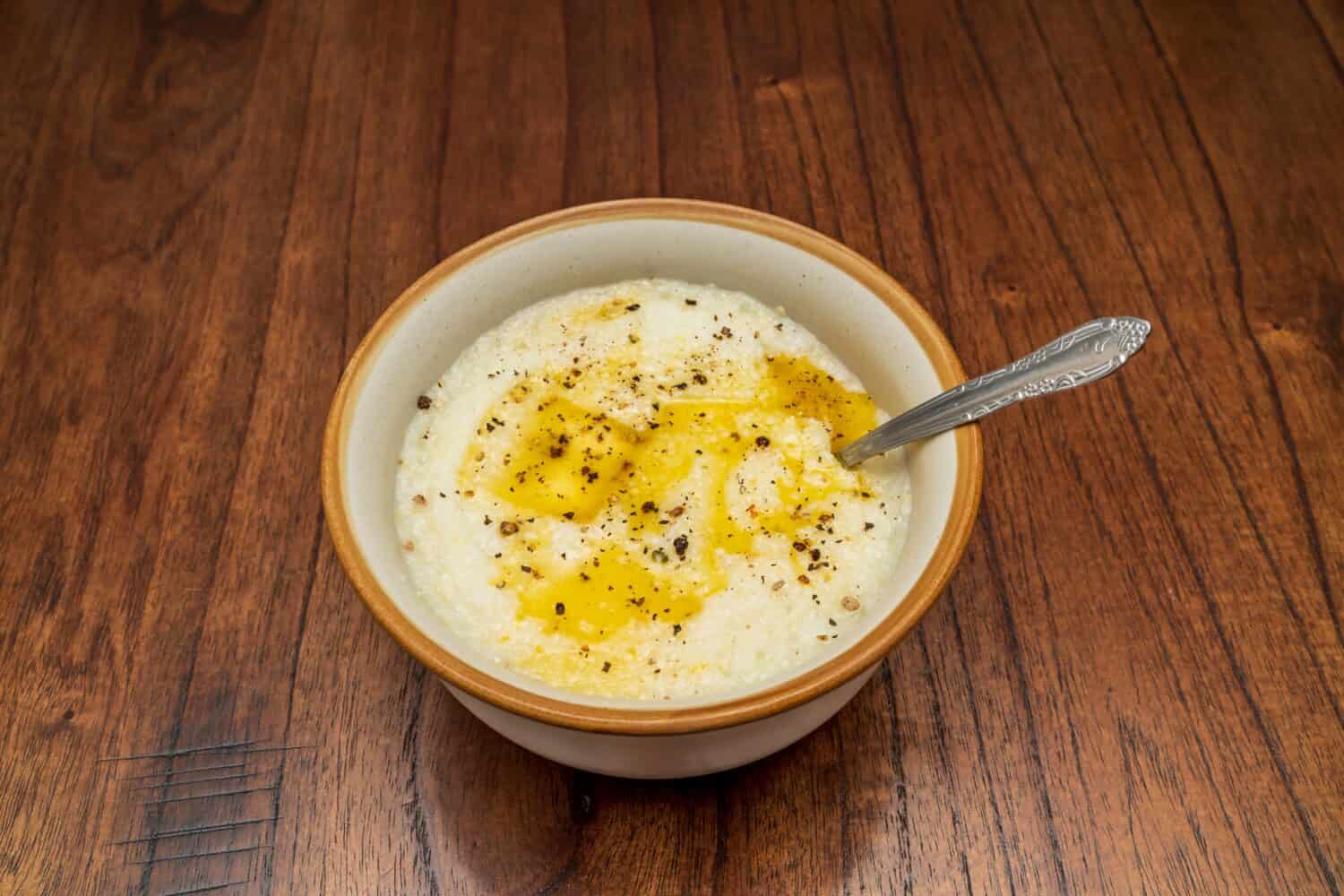Grits vs. Polenta vs. Cornmeal: Grits, polenta, and cornmeal are all produced using ground corn. Cornmeal, which is essentially coarse flour milled from maize (field corn), makes both grits and polenta. Like grits and polenta, cornmeal serves as a grain used for making baked products such as cornbread and corn muffins, serving its purpose as an ingredient or additive.
Despite being produced from ground maize, grits, and polenta differ in terms of textures, flavors, and preparation methods, and people consume them in various ways.
Get ready to take in each bite while we explore the fascinating world of grits, polenta, and cornmeal—where delectable inventions and culinary traditions collide.
Grits vs. Polenta vs. Cornmeal: What Are Their Differences?
Cornmeal, polenta, and grits are different corn-based products with varying textures and preparation methods. Here are their key distinctions:
1. Cornmeal
Cornmeal is a finely or moderately ground flour made from dried corn kernels. People commonly use it in baking for recipes like cornbread, muffins, and pancakes. It can also serve as a coating for fried foods or as a thickener in soups and stews.
- The must-have convenient reference guide for every home cook!
- Includes more than 8,000 substitutions for ingredients, cookware, and techniques.
- Save time and money on by avoiding trips to grab that "missing" ingredient you don't really need.
2. Polenta
Polenta is a classic Italian dish crafted from coarsely ground cornmeal. When cooked, it develops a slightly grainy texture and a smooth, creamy consistency. To prepare polenta, one simmers cornmeal in water or broth until it thickens. It is often served as a side dish, resembling mashed potatoes, or as a base for toppings like meats, vegetables, or cheese.
3. Grits
Grits are a staple in Southern United States cuisine, particularly in the southeastern states. They are made from coarsely ground corn, sometimes using a specific type called hominy. Compared to polenta, grits have a smoother texture. People typically simmer them in water or milk until they thicken. Grits are a popular breakfast dish and are often served with butter, cheese, or savory toppings like shrimp or bacon.
Overall, cornmeal, polenta, and grits differ in texture, preparation methods, and culinary uses. Cornmeal is a versatile flour suitable for baking and cooking. Polenta, an Italian dish, offers a creamy texture. Grits, a Southern favorite, have a smoother consistency and are commonly served for breakfast.

©Tatjana Baibakova/Shutterstock.com
Grits vs. Polenta vs. Cornmeal: Nutritional Value
Polenta, cornmeal, and grits, which all come from corn, have different nutritional values.
Grits, made from coarsely ground corn, provide moderate calories, carbohydrates, and dietary fiber. They have low-fat content and contain important minerals like iron and phosphorus. However, some nutrients may get lost during the refining process of grits.
Cornmeal, whether finely or moderately ground, is rich in carbohydrates and offers a good amount of dietary fiber. It is a good source of B vitamins such as thiamine and niacin. Cornmeal also contains antioxidants like zeaxanthin and lutein, which are beneficial for eye health.
Polenta, made from coarsely ground cornmeal, has similar nutritional qualities to cornmeal. It is a good source of carbohydrates and dietary fiber, providing sustained energy. Polenta also contains B vitamins and antioxidants, making it a nutritious choice.
Overall, while grits, cornmeal, and polenta all have nutritional benefits as corn-based products, their specific nutritional content may vary depending on the processing and refining methods. Including these corn-derived products in a balanced diet can contribute to energy, fiber, and essential nutrient intake.
What are grits?
Corn grits are a staple food in the Southern United States. Grits came from ground corn, usually from carbohydrate-rich, less sweet cultivars known as “dent corn.” Grits are commonly recognized as being made using yellow or white maize. To create them, yellow corn undergoes dry milling outside of a brewery. The milling process involves removing the endosperm hull, outer layers, and oil-rich germ, resulting in mostly endosperm pieces.
The best way to enjoy grits is by savoring them with savory toppings like bacon and cheese or with the delightful combination of butter and sugar. People also serve them for brunches or as appetizers before meals. Corn kernels naturally contain high levels of B vitamins, including niacin, folate, thiamin, and riboflavin, which are also present in grits and polenta.
Types of grits:
- Instant grits: This kind, which frequently comes in individual amounts, cooks instantly and is perfect for those who are looking for a quick and easy meal.
- Quick cooking grits: This only takes 5 to 10 minutes to cook. While they do have a longer shelf life, the manufacturing process causes them to lose the majority of their vitamins and minerals.
- Stone-ground grits: Stone-ground grits retain all of the benefits found in whole grains, such as fiber and B vitamins and minerals, since the dried entire corn kernels have been coarsely ground and did not lose their nutrients in the process. It takes approximately 45 minutes to make them.
- Hominy grits: Hominy grits come from corn kernels that have been steeped in a lime or lye mixture to loosen their hard outer hulls. The fiber is then taken out along with the outer shell. However, the germ remains there and carries nutrients such as vitamins E and B vitamins.
How to cook grits:
To prepare grits, you only need three ingredients: grits, water, and salt. However, for an better flavor, spices can be added. To add a little more flavor, add a small amount of bacon fat to the pot.
Simply bring four times the amount of water of the grits to a boil, season with salt, add the grits, and simmer for 45 minutes or so, mixing constantly. Cook using broth in place of water, then add cheese (if you like).
The cooking process may vary from different household, so it all comes down to personal choice, just like anything else. Get creative with it, then choose whatever flavor and texture you want your grits to have.

©New Africa/Shutterstock.com
What is polenta?
Farmers in Northern Italy invented the dish known as polenta. Traditionally, polenta is made using an Italian flint corn variety that has a somewhat coarse texture. This is a kind of cornmeal porridge that you can make with any type of cornmeal (ground coarse, medium, or fine). Although some individuals choose heritage types of corn more commonly, such as Otto File and Bianco Perla, any medium-grained or coarsely ground cornmeal would suffice.
- The must-have convenient reference guide for every home cook!
- Includes more than 8,000 substitutions for ingredients, cookware, and techniques.
- Save time and money on by avoiding trips to grab that "missing" ingredient you don't really need.
It makes the ideal serving dish for everything from meat, fish, and cheese to potatoes and vegetables. Restaurants frequently serve polenta as a creamy side dish together with chicken, steak, or spare ribs and serve as a topping for other dishes like salads.
The majority of polenta variants have only one ingredient: corn. As a result, polenta provides an excellent source of plant protein that makes following a healthy, balanced diet a breeze, notably for people who have health limitations.
Types of polenta:
- Course ground polenta: This type of polenta produces an extra-thick mixture that is ideal for frying and baking.
- Medium ground: Produces a creamy consistency that complements stews and slow-cooked foods such as beef stews.
- Fine white polenta: This came from finely ground white cornmeal that you can make into porridge in Italian cookery. The flavor is minimal, and the texture is silky and supple. Leave it to warm completely if you plan on using it for baking, sautéing, grilling, or frying.
- Uncooked polenta: In certain baking recipes, uncooked polenta may be used as a substitute for flour.
- Precooked (tube) polenta: This type is better when sliced and fried, sautéed, grilled, or baked. You must extend its cooking time by 10 minutes because of the thickness.
How to cook polenta?
Put the water into the pan and let it reach a boil. You can either use water, milk, or stock for the liquid, depending on the taste and texture you are trying to achieve. While mixing, add in the polenta and swirl for a couple of minutes to avoid clumping.
While it is cooking, you can add or reduce the amount of water.
When you find it grainy, put some more water on it. Mix it frequently as it cooks. The texture will gradually change and should form a swollen and porridge-like consistency.
Once done, add flavorings such as a large stick of cream or butter and a few grams of freshly grated Parmesan to give it a more smooth and creamy texture.
What is Cornmeal?
Cornmeal is a powdery food ingredient comparable to wheat flour manufactured from ground-dried maize kernels by means of one of many multiple processes resulting in various degrees of refinement.
A few people also refer to cornmeal as “corn flour.” Although “corn flour” (sometimes known as cornstarch) is a completely different ingredient. For generations, people have historically used cornmeal as a versatile culinary ingredient with multiple purposes.
You can use cornmeal to make different kinds of pastries, such as cornbread, muffins, and other types of baked products, as well as to thicken chilis and stews.
It is also a fantastic nutrient provider as it contains both fiber and selenium. It is beneficial for people who are trying to elevate their cardiovascular wellness owing to its high level of fiber.
Types of cornmeal:
- Stone-ground cornmeal: This type of cornmeal undergoes a stone-grinding process. As a result, portions of the shell and germ of the maize kernel are still present, preserving all the nutrients. Stone-ground cornmeal typically has a “cornier” taste and a more gritty feel to it. As a result, the end item becomes more nutrient-dense and accentuates the corn flavor.
- Medium-grind cornmeal: Typically yellow, with a coarse grind somewhat bigger than wheat flour, and has an identical diameter as pasta semolina. Medium Grind Cornmeal yields the greatest cornbread, with a fantastic texture and no surplus of crumbs. You can make it from whole-grain corn.
- Fine-grind cornmeal: You can make Fine Grind Cornmeal from entire yellow maize, and is great for coating buttered baked potatoes to get a crunchy and crisp skin.
How to Cook Cornmeal:
Combine the cornmeal, milk, and salt in a small mixing bowl. Pour the mixture gradually into the boiling water. Cook the cornmeal for about 10 minutes, after which it swells and resembles porridge. The cornmeal needs time to expand and finish cooking. By doing so, you may highlight the corn's sweet flavor rather than having a bland, bitter result. After cooking, you can always top it with more spices or cheese.

©Kristi Blokhin/Shutterstock.com
Final Thoughts
In general, the fundamental distinction between grits, polenta, and cornmeal is in their textures, origin, preparation, and the way you consume each of them. Discovering the grainy possibilities offers the chance for a diverse dining experience and the ability to customize them to individual taste preferences and cooking goals.
While each of them has unique uses, characteristics, and flavors, you can always immerse yourself in a realm of culinary innovation as you uncover the kitchen's unlimited possibilities.
Allow the charm of grits, polenta, and cornmeal to draw in your adventurous soul as you go on a culinary venture that will leave you wanting more.
PrintCrock Pot Chicken with Cornmeal Dumplings
Ingredients
- 1 (9 oz.) pkg. frozen cut green beans
- 2 cups cubed, cooked chicken
- 2 cups diced potatoes
- 1 (13 3/4 oz.) can chicken broth
- 1 (12 oz.) can vegetable juice cocktail (1 1/2 cups)
- 1/2 cup sliced celery
- 1/2 cup chopped onion
- 1 teaspoon chili powder
- 1/2 teaspoon salt
- 6 drops bottled hot pepper sauce
- 1 1/4 cups packaged biscuit mix (like Bisquick)
- 1/3 cup yellow cornmeal
- 1 cup sharp shredded cheddar cheese
- 2 Tablespoons fresh parsley
- 2/3 cup milk
Instructions
- Thaw beans by placing in strainer and run hot water over beans. Transfer to crock pot.
- Add chicken, potatoes, chicken broth, vegetable juice, celery, onion, chili powder, salt and hot pepper sauce, mixed together. Cover.
- Cook on low for 4 hours. Turn to high heat and heat until bubbly. Add water at this point if needed.
- Combine biscuit mix, cornmeal, 1/2 cup of the cheese and parsley. Add milk and stir until just moistened.
- Drop by tablespoons onto stew; cover. Cook 2 1/2 hours more (don't lift cover). Sprinkle dumplings with rest of cheese.
The image featured at the top of this post is ©Georges_Creations/Shutterstock.com.
- The must-have convenient reference guide for every home cook!
- Includes more than 8,000 substitutions for ingredients, cookware, and techniques.
- Save time and money on by avoiding trips to grab that "missing" ingredient you don't really need.


